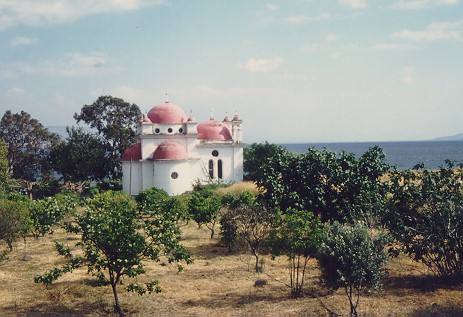|

Kfar Nachum (Capernaum) Synagogue and Church
Attractions: A site where Jesus preached; remains of a town with a large synagogue, and St. Peterís house.
Location: [36] on map, on Highway 87. Public buses stop at the intersection about 2 km. from the church.
Hours: Synagogue 8:30-16:45; Church 8:30-11:30; 15:30-16:45.
Comments: Entrance fee. Modest dress required (no shorts or tank tops).
The following links are from Google Ads.
We have no control over the content.
Stones from the Synagogue
Enter and turn right at the ticket office. The six-pointed star today known as the Star of David was not a Jewish symbol 2,000 years ago. Here the six-pointed star appears next to a five-pointed star. Look for representations of some of the seven species with which the Land of Israel is blessed (grapes, pomegranates, date palms, and olives). (Deuteronomy 8:8)
One stone shows a pair of pillars similar in design to those found at Hamat Tiberias, a motif also found in Roman temples. The Aramaic inscription refers to a donor. The next stone depicts a temple on wheels, perhaps representing the tabernacle that traveled with the Jews in the desert. Continue around to the area below the churchÖ.
The following links are from Google Ads.
We have no control over the content.
The Church
Tradition holds that this was Peterís house. It served as a meeting place for believers during Christianityís formative years. One hundred thirty-one inscriptions in Greek, Aramaic, Syrian, and Latin, many including Jesusís name, were discovered in the plaster. The octagonal building was enlarged over the years. This is the only building in Kfar Nachum found with a mosaic floor; in front of you a fragment of it is on display. The sign in front of the mosaic explains the stages of the buildingís construction as they were uncovered by archaeologists. In the middle of the fourth century alterations were made to the house; it was enlarged and separated from the town by a wall.
In the fifth century all the private homes of the insula ("city block") were destroyed to make way for construction of the church. Preserving the houseís original shape, the church was octagonal, with an apse, and a baptistery in the center (as illustrated in the signís bottom diagram). In the seventh century the town was apparently abandoned and the site forgotten until the Franciscans bought the land in the late nineteenth century.
The Franciscans conducted archaeological excavations and restored the synagogue and the church. Recently they built the modern church over the site of St. Peterís house. The glass floor in the center of the church allows you to look into the original church below.
The Synagogue
This is the second largest Byzantine period synagogue yet found in Israel. Historians disagree on the date of its construction, though they agree it was built long after the time of Jesus. Its white limestone, brought to Kfar Nachum from some distance, contrasts with the local black basalt. The lintelsí ornamentation includes geometric designs, plants, and animals; a stone eagle, later destroyed by iconoclasts, hovered over the entrance. Pillars in ďUĒ formation supported the second floor and the roof. The inside walls were plastered and the floor was of stone. The congregation sat along the walls facing the center, where the Torah was probably read. A large room and courtyard, possibly the house of study, stood adjacent and to the east of the synagogue.
History in the Light of Archaeology
The archeological finds raise interesting questions. When was the synagogue built? Who paid for it? Kfar Nachumís houses were simply built of local basalt, no signs of wealth were discovered, yet here stood an impressive synagogue built of imported stone. Did a friendly Roman help (see above, Luke 7:1-5), or perhaps Julian the Apostate? Kfar Nachum is the only place where a large synagogue was found next to a church. Considering the tension between Jews and Christians under Byzantine rule, their proximity is remarkable. Was there a special relationship between Jews and Christians here?
The following links are from Google Ads.
We have no control over the content.
The following are some conjectures:
- Kfar Nachumís Jews and early Christians enjoyed good relations.
- Kfar Nachum was a Jewish town. Byzantine rulers built the church to consecrate Peterís house, but there was no indigenous Christian population.
- Kfar Nachum was a Christian town. Local "tourism promoters" wanted to show pilgrims the synagogue Jesus cursed. The original synagogue was
nowhere to be found, so they brought one from elsewhere.
From The Complete Guide to Tiberias and the Sea of Galilee,
by the late guide for all of Israel, Yisrael Shalem.
While in Capernaum, visit Tiberias
just around the corner on the Sea of Galilee (Lake Kinneret).
|